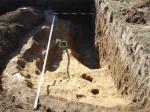Summary (English)
At the end of October 2006, a rescue excavation was carried out at 62 Josip Kozarac Street in Vinkovci (cadastral plot 3381, cadastral municipality of Vinkovci). The position is located within the protected archaeological zone of Vinkovci, in the area of Krnjaš, which extends on the left higher bank of the Bosut River, southwest of the central town square. Krnjaš covers the area from the beginning of Josip Kozarc Street to the confluence of the Nevkoš stream in Bosut where the Dirov brijeg position is located. Previous excavation has shown the continuity of occupation from the Vučedol culture (house no. 60), the Slavonian-Srijem Vatin culture (house no. 24, 28, 70), the Belegiš II culture (house no. 24, 28) to the period of Early and Late Iron Age (house no. 64 – 68, Dirov brijeg). Finds from the Roman period originate from the ceramic workshop centre located at Krnjaš where a total of 11 kilns were found on Josip Kozarac Street. The entire street is located on an elongated slight elevation that extends to the southern bypass of the city. During the construction of the bypass in 2003, a Roman site and the medieval settlement of Liskovac were discovered.
The excavation included a basement measuring 8.16 × 6.20 m with a staircase measuring 4.60 × 3 m, and foundations on an area of 8 × 7.50 m, 0.40 m wide and 0.80 m deep. Underneath the dark brown layer with fragments of recent rubble (SU 1) there is a brown layer with finds of prehistoric pottery (SU 2). This is followed by a pre-subsoil layer with finds of prehistoric pottery (SU 9), and a yellow archaeologically sterile loam – a subsoil (SU 10). In the excavation area, one pit with medieval pottery, seven pits from the La Tène period (one of which also contained early Roman finds), and part of a large sunken floored building with artefacts of the Sopot and Starčevo culture were excavated. Prehistoric pottery was found already inside SU 2, and some early Roman finds (pottery of La Tène forms) were only found in SU 13. Preliminarily, prehistoric pottery can be divided into the following periods: Late and Early Iron Age, Bronze Age and Neolithic. In addition to fragments of pottery, a large number of special finds were also discovered, of which two almost complete La Tène kantharoi, fragments of an altar of Starčevo culture, a fragment of a painted vessel of Starčevo culture, several painted bowl legs, a large number of loom weights and spindle whorls, and knapped stone artefacts from all prehistoric periods (Anita Rapan Papeša 2007, Hrvatski arheološki godišnjak 3/2006, 60–61).
- Anita Rapan Papeša - Gradski muzej Vinkovci
Director
- Anita Rapan Papeša - Gradski muzej Vinkovci
Team
Research Body
- Gradski muzej Vinkovci






![Download [PDF]](/excavation/skins/fasti/images/results/download_sml.png)